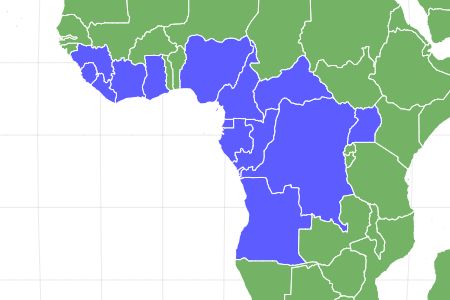African Golden Cat
Caracal aurata
The first image of an African golden cat was captured in the wild in Gabon in 2002.
Advertisement
African Golden Cat Scientific Classification
- Kingdom
- Animalia
- Phylum
- Chordata
- Class
- Mammalia
- Order
- Carnivora
- Family
- Felidae
- Genus
- Caracal
- Scientific Name
- Caracal aurata
Read our Complete Guide to Classification of Animals.
African Golden Cat Conservation Status
African Golden Cat Facts
- Prey
- Rodent, fish, small antelope, tree hyraxes, monkeys, red duikers, birds
- Main Prey
- rodents
- Name Of Young
- Cubs
- Group Behavior
- Solitary
- Fun Fact
- The first image of an African golden cat was captured in the wild in Gabon in 2002.
- Estimated Population Size
- 10 000
- Most Distinctive Feature
- Small rounded head
- Distinctive Feature
- Bobtail
- Gestation Period
- 75 to 78 days
- Litter Size
- 1 to 2 cubs, though 3 have been reported
- Habitat
- Dense forest
- Diet
- Carnivore
- Average Litter Size
- 1 to 2 cubs, though 3 have been reported
- Lifestyle
- Nocturnal/Crepuscular
- Favorite Food
- Rodents
- Common Name
- African Golden Cat
- Number Of Species
- 1
- Location
- Angola; Cameroon; Central African Republic; Congo; Congo, The Democratic Republic of the; Côte d'Ivoire; Equatorial Guinea; Gabon; Ghana; Guinea; Liberia; Nigeria; Sierra Leone; Uganda
African Golden Cat Physical Characteristics
- Color
- Fawn
- Red
- Blue
- Black
- White
- Cream
- Skin Type
- Fur
- Lifespan
- 12 years
- Weight
- 15 to 35 pounds
- Height
- 15 to 22 inches
- Length
- 24 to 40 inches
- Age of Sexual Maturity
- 11 to 18 months
- Age of Weaning
- 6 months
- Aggression
- Medium
View all of the African Golden Cat images!
The first image of an African golden cat was captured in the wild in Gabon in 2002.
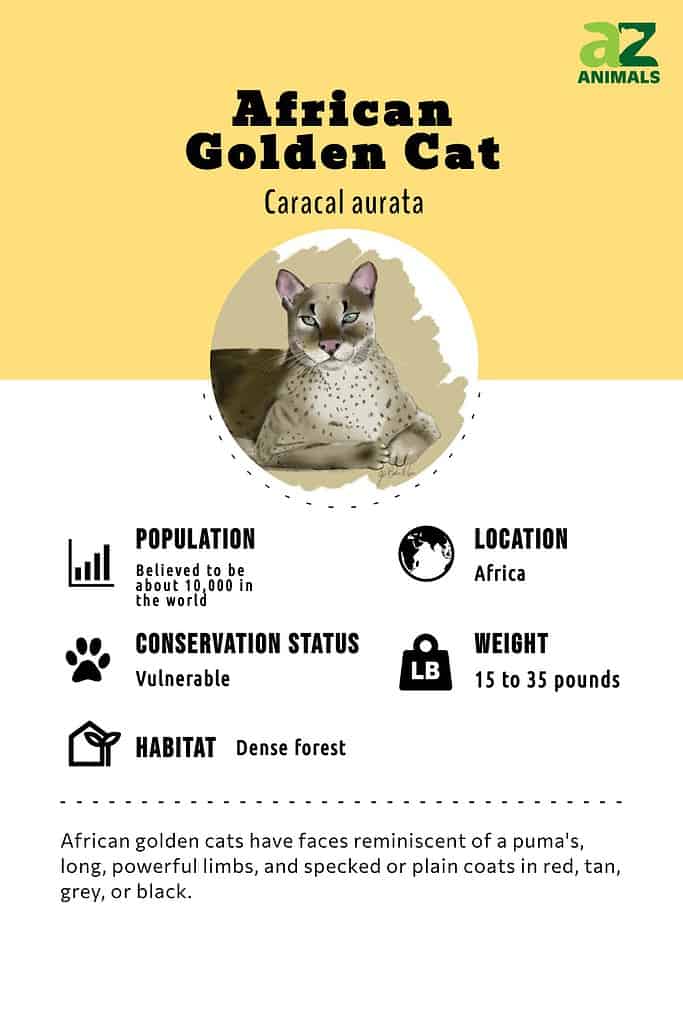
Conservation Status
The African Golden Cat is an elusive animal rarely observed in its natural habitat. The IUCN Red List declared the species as Vulnerable and on the decline because of habitat loss caused by commercial farming, wood and pulp plantations, hunting, and mining.
They are hard to study because of their shy nature and densely forested habitats. As a result, scientists don’t know much about their behavior and lifestyle, and most information about the species results from dietary studies and museum specimens.
Sadly, the African golden cat has lost 44% of its habitat. This is because they don’t migrate and depend on tropical forested areas. There is no way they could survive in regions with abundant human disturbance. Unfortunately, the forested areas in west Africa are severely damaged by construction, primarily by building roads.
By making it easier to venture deeper and deeper into the forests, it opens up doors for poachers in the bushmeat trade to get closer to these cats. For example, African golden cats are often caught in snares used in illegal hunting methods.
In some African countries, Golden cat skins are in high demand because they are used in traditional medicine. The skin is also used as a valuable wrap for objects.
Subspecies
The African golden cat has two subspecies, namely the:
- Caracal aurata aurata
- Caracal aurata celidogaster
Evolution
Between 7 – 12 million years ago, the evolutionary branch known as the caracal lineage broke away. By about 6 – 9 million years ago, the ancestor of the wild feline had made its way to Africa.
Between about 1 – 3 million years ago, the species Caracal caracal and Caracal aurata, or the caracal and the African golden cat had diverged into separate evolutionary pathways.
Anatomy and Appearance
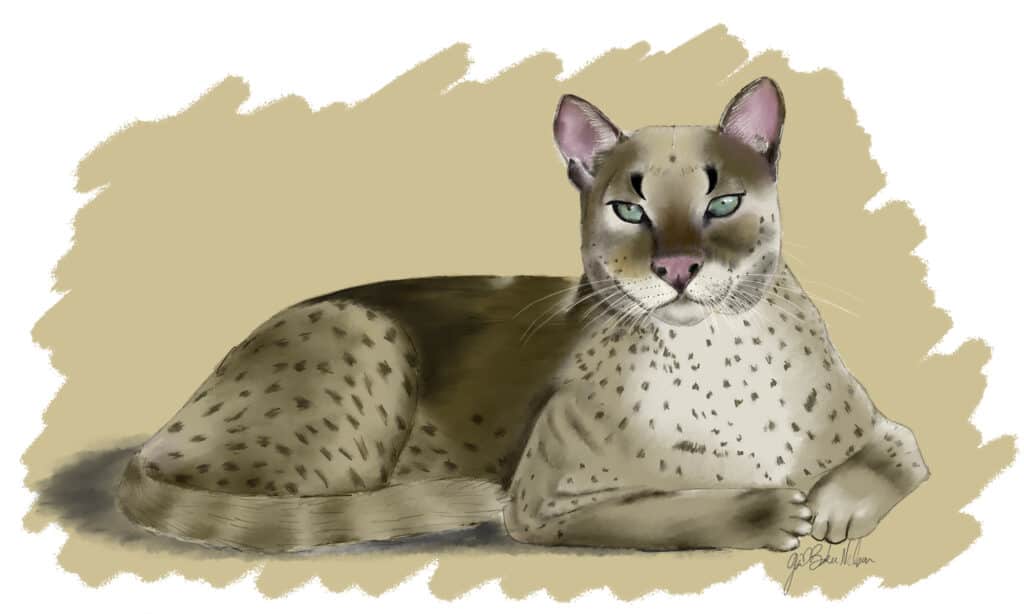
These cats come in several colors: reddish-brown, chestnut, greyish-brown, and black. Their patterns also vary; some have light spots, while others have darker spots. However, other African golden cats only have spot patterns on their inner legs and belly.
In addition, they are lighter in color (almost white) around their eyes, cheeks, chin, throat, and undersides. Their tails also vary, with some being darker and heavily banded, while others are lightly banded or plain. However, their tails always end with a black tip.
Their color variations and patterns tend to change due to their location. For example, African golden cats in the western territories have more spotting (making them darker) while they are lighter with minimal spotting in the eastern regions.
They have a small rounded head that almost looks disproportionate compared to their body size. On the other hand, the African golden cat is muscular with a bulky frame, long legs, large paws, and a short tail.
Their length varies but is usually between 24 to 40 inches and can grow to heights of 15 to 22 inches. Males weigh more than females, but their general weight ranges between 12 to 35 pounds.
They look very similar to the caracal, but there are a few differences, like the African golden cat doesn’t have tufts on the ears, its tail is longer, and its face is shorter and more rounded. In addition, their ears are small and round, and they have pale blue to brown eyes.
Distribution and Habitat
African golden cats depend on a forested environment for survival. They typically occur in tropical Africa, and their population is primarily split between two areas, along the west coast up to the north, and in west central Africa.
This species lives in moist rainforests and are typically found from sea level up to 3,600 meters in dense rainforests, bamboo forests, alpine moorland, montane forests, riverine forests, and wooded savannah.
Their populations thrive in undisturbed forests, with dense understory vegetation and an abundance of rodents.
Behavior and Lifestyle
Unfortunately, there is little information on the African golden cat’s behavior and lifestyle, and what data does exist comes from only a few observations. But, surprisingly, people have known about them for almost 200 years.
The first image of an African golden cat was captured in the wild in Gabon in 2002. Then, in 2008, the second photograph was caught in Kibale Nation Park of Uganda, and in 2009 a local witnessed one hunting a small mammal on a deserted road in Bwindi Impenetrable National Park.
However, since 2010, hundreds of sightings and images in Gabon and Uganda have been captured thanks to modern technology like camera traps. From this evidence, scientists have determined that this species is solitary.
Typically, they share their territories with leopards and have to compete with them for food. However, leopards prey on African golden cats, which are scarce in areas with large leopard populations.
African golden cats are cathemeral (active during the day and night), but in areas where there are leopards (nocturnal), they are more active during the day.
There is not much information on the African golden cat’s hunting behavior; however, scientists have determined that most of their hunting takes place on the ground, but they do hunt in trees occasionally.
Reproduction and Life Cycle
Because this cat is so shy, their mating rituals are currently unknown. There has only been one sighting of two African golden cats together. Clearly, researchers need to gather more information on the African golden cat to fully understand their reproduction and life cycles.
However, there is some evidence gathered from captive African golden cats. Litters usually consist of 1 to 2 cubs but occasionally include three cubs. Mothers retreat to a hidden den to give birth, usually under a hollow tree. Gestation is relatively quick, between 75 to 78 days, and cubs weigh about 6.3 to 8.3 ounces when born.
African golden cat cubs are born blind, and their eyes generally take seven days to open. They grow quickly and, by two weeks, can already climb. Then, at six weeks, they begin weaning. Sexual maturity differs between males and females. Females reach sexual maturity first at 11 months and males at 18 months. African golden cats can live up to 12 years old in the wild.
Diet and Prey
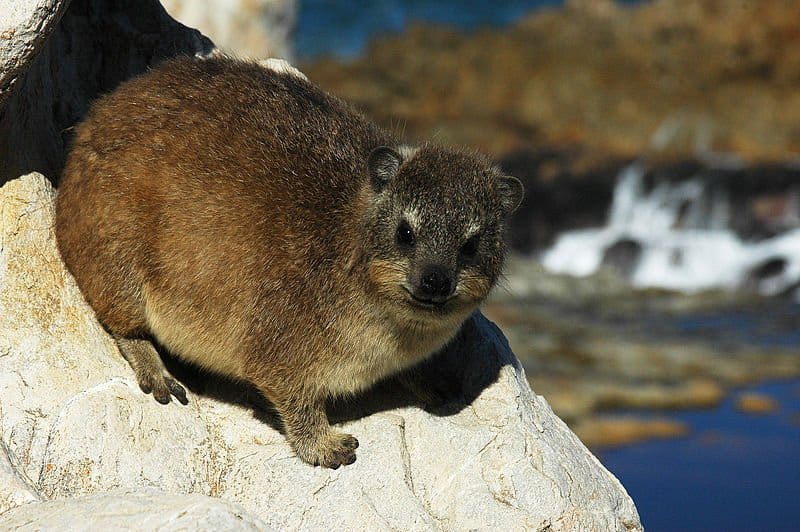
African golden cats hunt hyraxes
©Amada44 – Public Domain
African golden cats are carnivores and generally prey on smaller mammals like:
While these cats have been recorded hunting monkeys, they primarily prey on small primates that are injured or that fall out of trees.
When hunting birds, they will often pluck the feathers before eating. This mimics the caracal’s eating behavior due to the amount of feathers they pluck before indulging.
Predators and Threats
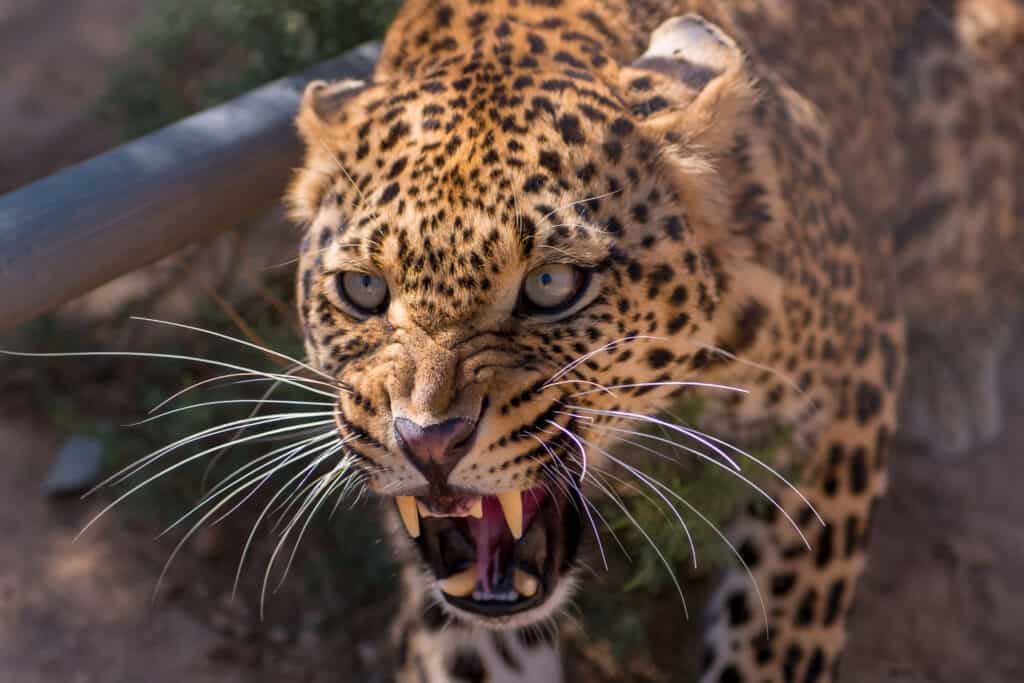
Leopards usually hunt African golden cats
©Mohamed Hakem/Shutterstock.com
Leopards prey on African golden cats, but they prefer the same territories, so the African golden cats try to avoid leopards by being more active during the day while the Apex predators are sleeping.
Unfortunately, their main threat is habitat loss caused by deforestation, especially in Eastern and Western Africa. Due to the human population increasing, more and more of the environment is destroyed to make way for infrastructure.
The building of roads has increased significantly in Africa in the past decade, especially in the Democratic Republic of the Congo and the Congo.
Another threat to the African golden cat is the bushmeat trade. By making the denser forest areas more accessible through new roadways, these countries have made hunting easier for poachers. As a result, the bushmeat trade has flourished, and African golden cats often get caught in their snares.
Although these cats are not their target prey, poachers will still sell their meat for consumption, and natives believe their fur and skin are a good luck charm during hunting. In addition, tribes use their fur in rituals and to wrap items.
Farmers do not consider these cats pests as there are not many records where an African golden cat has attacked livestock. However, this does not stop locals living in human settlements from killing them, as they could harm some of the livestock if they wanted to.
Interesting Facts
While the African golden cat is timid, and there is not a lot of information on record about them, here are some interesting facts:
- The African golden cat is an excellent climber but prefers to hunt and live on the ground majority of the time.
- African golden cats mark their territory by spraying scent and smearing feces on their boundaries
- These cats share their habitat with leopards, their biggest predator, but try their best to avoid them.
- These cats are primarily solitary animals; however, males and females come together during mating season.
- Their gestation period lasts between 75 to 78 days, usually resulting in one or two kittens
- The mother will retreat to a hidden den when she is ready to give birth, usually in a hollow tree
Relationship and Humans
The African golden cat does not have a good relationship with humans. Natives have hunted them illegally for years for their meat and pelts.
Their fur is valuable and used for:
- Circumcision rituals
- To wrap objects
- As a good luck charm for hunting
Chicken, goat, and sheep farmers consider them pests and will kill them, even though there are very few recorded livestock attacks.
Zoos
The African golden cat is not well-known, and there haven’t been many of them kept in captivity and the ones that were have long passed away. At present, there are no golden cats in zoos anywhere in the world.
Animals Similar to the African Golden Cat
Only two other African cats are similar to the African golden cat: the caracal and serval.
Caracal
The caracal is an underestimated predator that is more powerful than it looks. They have reddish-brown fur, a bobtail, and long black pointy ears with tufts on the ends. They are incredible jumpers because their hind legs are longer than their front legs, which propels them to heights of 10 feet. Needless to say, birds don’t stand a chance against these stealthy predators.
Interesting Facts About the Caracal
- The saying “put the cat among the pigeons” stems from ancient India and Iran, where they would put trained caracals into arenas containing multiple pigeons. Bystanders would bet on how many birds the caracal would catch in a single jump.
- Caracals aren’t only indigenous to Africa and also found along the Arabian Peninsula up to Pakistan and Western India.
- Similar to the leopard, some caracals will hide their prey in trees. This usually occurs in areas with large hyena populations.
- There are apparent similarities between the caracal and the lynx. However, scientists now believe that the caracal is more closely related to the serval and African golden cat than to any species of lynx.
- In South Africa, caracals are considered pests and often hunt livestock for fun, killing more than one animal even though they won’t eat it. Farmers get very frustrated and kill them. Between 1931 to 1952, 2,219 caracals were killed in a tiny area of South Africa.
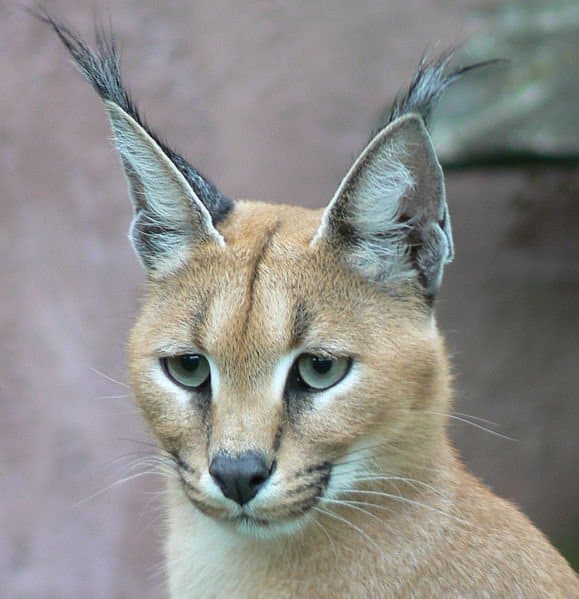
Caracals, are similarly sized wild cats that scientists believe are closely related to African golden cats.
Serval
Servals are beautiful medium-sized cats scattered across the African continent. They prefer grasslands and wetlands; however, they are adaptable and can survive in different ecosystems.
Although they have disappeared from some African countries due to habitat loss and hunting, they are listed as Least Concerned on IUCN’s Red List. This is because they still have high numbers in the wild, and their populations remain stable.
Servals can become very tame, and some people keep them as pets, even though it’s illegal to own one in many places because they can harm people with their sharp teeth and claws.
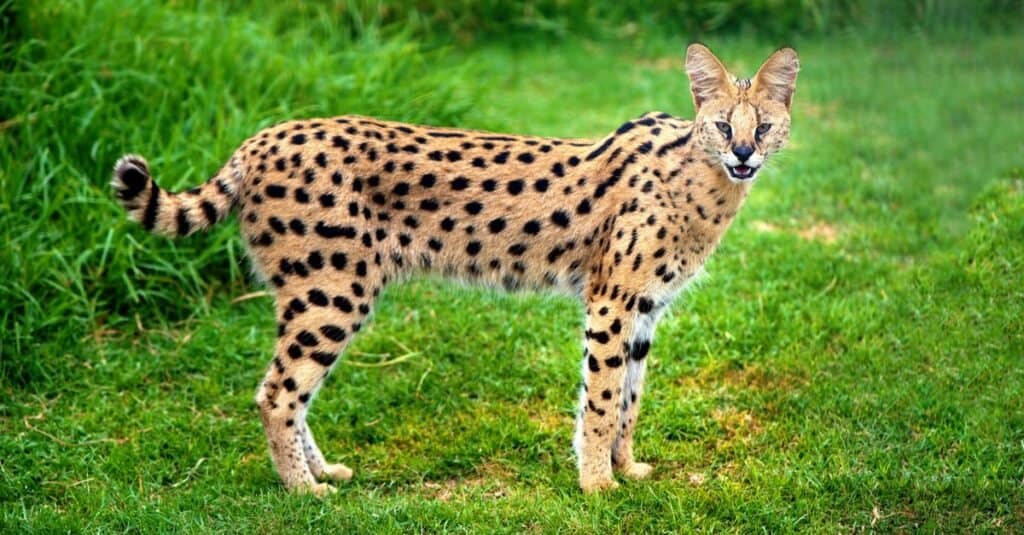
Servals are also similar in size to African golden cats. They can become very tame and some people keep them as pets.
©Howard Klaaste/Shutterstock.com
Interesting Facts About Servals
- Servals are skilled hunters and are successful 50% of the time. That’s very good compared to other cat species, which only have a 10% success rate. They are so impressive; that they can even catch flying birds.
- Servals have both stripes and spots on their bodies which help them blend into their surroundings.
- Servals have an impeccable sense of smell, sight, and hearing, which is one of the reasons they are such skillful hunters and good at avoiding threats.
- Servals have several predators, which include people, dogs, leopards, and hyenas
- The only land animal faster than a serval is a cheetah. Servals can run between 45-50 miles per hour.
African Golden Cat FAQs (Frequently Asked Questions)
How many African golden cats are left in the world?
There is no proven data on the size of their population. However, researchers believe around 10 000 African golden cats are left in the wild.
Where are African golden cats found?
African golden cats depend on a forested environment for survival. They typically occur in tropical Africa, and their population is primarily split between two areas, along the west coast up to the north, and in west central Africa.
How big is an African golden cat?
Their length varies but is usually between 24 to 40 inches and can grow to heights of 15 to 22 inches. Males weigh more than females, but their general weight ranges between 12 to 35 pounds.
What eats African golden cat?
Leopards prey on African golden cats, but they prefer the same territories, so the African golden cats try to avoid leopards by being more active during the day while the Apex predators are sleeping.
Thank you for reading! Have some feedback for us? Contact the AZ Animals editorial team.
Sources
- Wikipedia, Available here: https://en.wikipedia.org/wiki/African_golden_cat
- Wild Cat Conservation, Available here: https://wildcatconservation.org/wild-cats/africa/african-golden-cat/
- Cat Specialist Group, Available here: http://www.catsg.org/index.php?id=106
- Animalia, Available here: https://animalia.bio/african-golden-cat
- Earth's Endangered Creatures, Available here: http://www.earthsendangered.com/profile.asp?gr=M&ID=1&sp=10075

